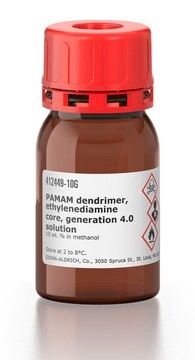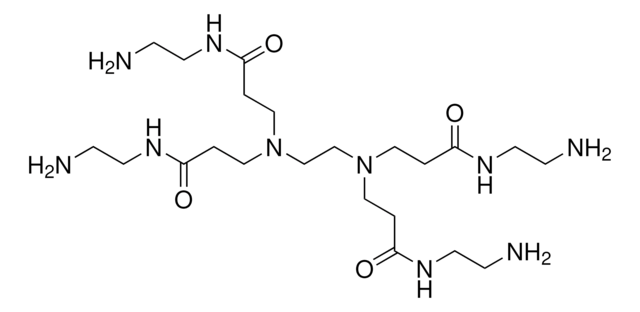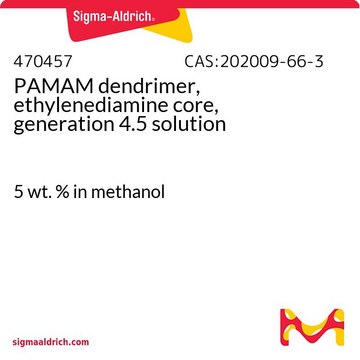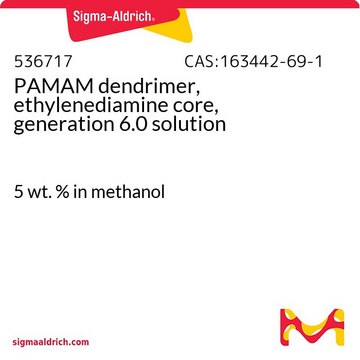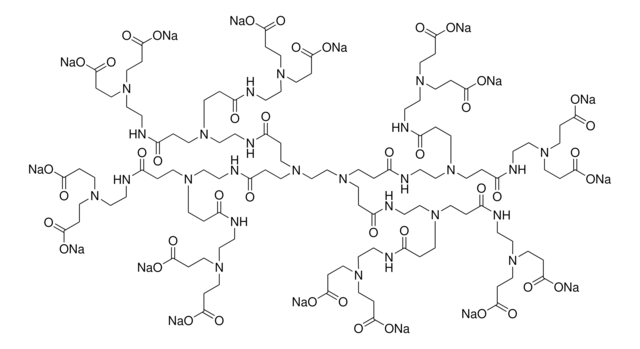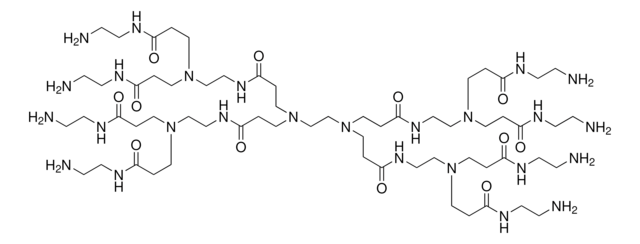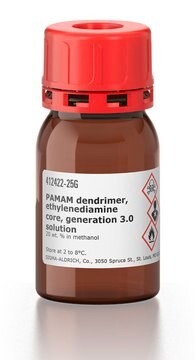536709
PAMAM dendrimer, ethylenediamine core, generation 5.0 solution
5 wt. % in methanol
Synonym(s):
Poly(amidoamine)
About This Item
Recommended Products
description
amino surface groups
Quality Level
form
liquid
mol wt
generation 5.0
feature
core type ethylenediamine core (2-carbon core)
concentration
5 wt. % in methanol
no. Surface Groups
128
density
0.797 g/mL at 25 °C
storage temp.
2-8°C
General description
Application
- Synthesis of beta-Cyclodextrin-Decorated Dendritic Compounds Based on EDTA Core: This study presents an alternative to the ethylenediamine core in PAMAM dendrimers, using an EDTA core instead, providing insights into modifications that affect the dendrimers properties (Gonzalez Mendez et al., 2022).
- New Advances in General Biomedical Applications of PAMAM Dendrimers: Discusses the composition variations of PAMAM dendrimer cores, including ethylenediamine, and their implications on biomedical applications (Araujo et al., 2018).
- Poly (amidoamine) Dendrimers: Covalent and Supramolecular Synthesis: This paper reviews various synthetic strategies for PAMAM dendrimers, emphasizing the role of the ethylenediamine core in their structural formation (Lyu et al., 2019).
- Modified Carboxyl-Terminated PAMAM Dendrimers as a Cytocompatible Nano Based Drug Delivery System: Examines the biocompatibility and drug delivery efficiency of modified PAMAM dendrimers, highlighting the cores critical role (Vu et al., 2019).
- Use of Polyaminoamide Dendrimers Starting from Different Core-Initial Molecules for Inhibition of Silica Scale: This study explores the use of ethylenediamine-core PAMAM dendrimers in industrial applications, particularly for silica scale inhibition (Sun et al., 2021).
Physical form
Legal Information
signalword
Danger
Hazard Classifications
Acute Tox. 3 Dermal - Acute Tox. 3 Inhalation - Acute Tox. 3 Oral - Flam. Liq. 2 - STOT SE 1
target_organs
Eyes
Storage Class
3 - Flammable liquids
wgk_germany
WGK 3
flash_point_f
49.5 °F - closed cup - Methanol
flash_point_c
9.7 °C - closed cup - Methanol
Choose from one of the most recent versions:
Already Own This Product?
Find documentation for the products that you have recently purchased in the Document Library.
Customers Also Viewed
Articles
Environmental concerns are driving the replacement of volatile organic solvents by water and aqueous mixtures. This change often creates challenges because many organic molecules show low water solubility.
Our team of scientists has experience in all areas of research including Life Science, Material Science, Chemical Synthesis, Chromatography, Analytical and many others.
Contact Technical Service